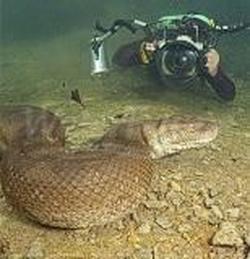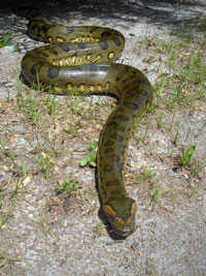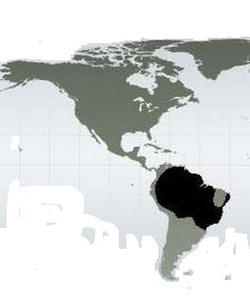Green AnacondaEunectes murinus |

Custom Search
|
|
The green anaconda (Eunectes murinus) lives throughout the tropical South America, mostly found east of the Andes through the Amazon and Orinoco river basins, as well as in Colombia, Venezuela, Brazil, the Northern regions of Bolivia, north-east Peru, Guyana and French Guiana. They are also found on the island of Trinidad off the Venezuelan north-east coast.
This is a semi-aquatic non-venomous snake species, the green anaconda is typically found in swamps, marshes and slow-moving rivers and streams. Either in the seasonally flooded savanna, such as Llanos grasslands of Colombia and Venezuela or in the rivers of the vast Amazon and Orinoco basins. Green anacondas grow as long as 29 feet, with a girth of 12 inches (30 centimeters) in diameter and weigh as much as 550 pounds, this undoubtedly one of the world’s largest snakes and much larger than their cousin the yellow anaconda (Eunectes notaeus). It's the considered the heaviest snake and only the reticulated python grows slightly longer than the green anaconda but it weighs much less, due to the enormous girth of the anaconda making it almost twice as heavy. The green anaconda also exhibits the greatest sexual dimorphism between the sexes of any terrestrial vertebrate, females dwarf males in length and are almost 5 times heavier.

These massive snakes are clumsy on land because of their sheer weight, but they are sleek and stealthy when in the water.
They have the eyes and nostrils located on top of their heads enabling it to breathe and see while they remain nearly completely submerged, allowing the anaconda to lay in wait for their unsuspecting prey. The green anaconda coloring is typically an olive green background with oval black spots running down the back and smaller oval spots with yellow centers along the sides, providing excellent camouflage. Their head is relatively small sized when compared to the thick body with distinctive orange-yellow striping on the sides. Its scientific name Eunectes murinus derives from the Greek word "ευνήκτης" meaning "good swimmer" and the Latin "murinus" meaning "of mice" since it was thought they preyed on mice. The species is known by other common names including anaconda, common anaconda, and water boa, and also several local names like the Spanish term mata toro (it means literally "bull killer") or sucuri in the Tupi language among many others. The species average lifespan is about 10 years but may exceed 30 years. Diet / Feeding
The green anaconda feeds on a variety of prey according to their size, with smaller specimens eating mainly fish like piranhas and other small vertebrates like turtles and birds, they even climb trees to raid bird nests. The larger green anaconda snakes prey upon animals as big as deer, capybara (a giant rodent), tapirs and even full-grown spectacled caimans and jaguars, they are also cannibalistic with females often feeding on the smaller male green anacondas. They also attack and eat livestock or pets like sheep and dogs and in rare cases, these large constrictors are also known to attack humans. The snakes use its teeth and powerful jaws to hold onto the prey while their massive and extremely muscular body wrap around the prey to suffocate or drown it. They are capable of unhinging their jaws to swallow their prey whole, even big animal like deer. The green anaconda has a very slow digestive system, it will often take days or weeks for it to digest food, after a meal the snake may not eat again for weeks or months. Reproduction The green anaconda reproduces sexually and uses internal fertilization, the species takes around 6 years to reach sexual maturity. The courtship and mating season typically occurs between mid-February to late May, the female lays down a pheromone trail, which attracts the males. These snakes are solitary until the mating season, during this period the green anaconda clusters in a breeding ball that may consist of 2 up to 13 males coiled around one female snake. The snakes may stay together up to a month during which the female may mate multiple times. After mating the female snake may eat one or more of its male counterparts. This may help it to survive pregnancy, since during the gestation period the female will not feed from 6 to 10 months, in order to survive the dry season, they shelter underground in caves or the mud in river banks, they may also seek out deeper water. The green anaconda is an ovoviviparous snake species this means produces eggs that hatch inside the female’s body and the hatchlings are born live as fully formed tiny anacondas. Measuring around 2 ft (60 centimeters) in length they are immediately able to swim and hunt. This type of birth is called ovoviviparous, meaning “ovo” for egg, “vivi” for live and “parous” for birth. The female can give birth from anywhere from 4 up to 82 live young, depending on the size of the snake, but typically the litters range from 20 to 40.
Conservation / Threats
The green anaconda is listed on Appendix II of CITES, which regulates its commercial trade through the use of permits and annual export quotas. Although the species not yet assessed by the IUCN, the green anaconda faces several threats, that could have a significant impact on its population. The habitat loss and degradation due to deforestation threaten the species, even in areas where habitat protection exists, it lacks enforcement. They are also hunted, both legally and illegally, in many parts of its range for their skin and for sale in the growing, illegal exotic pet market. Conservation initiatives are urgent to prevent the species decline, ecotourism might be one of the most effective ways to conserve and protect these amazing snakes. |
Did You Know?
The gaboon viper has the longest fangs measuring up to 2 inches (5 cm), and also the highest venom yield of any venomous snake. Scientific Classification |
© 2014 Snake Facts About Us | Privacy Policy | Contact







